Patrick Leahy Burlington International Airport (BTV)
Patrick Leahy Burlington International Airport (BTV) is a medium-sized multi-use airport, located just east of the city of Burlington, Vermont. It serves the air carrier, general and corporate aviation communities and is home to the Green Mountain Boys of the Vermont Air National Guard. The traffic mix of light general aviation, air carrier, and tactical fighter aircraft, makes BTV a complex environment for pilots and controllers. View a printable Pilot Handbook of the BTV information found on this Web page.
Know Before You Go
The airport configuration consists of primary RWY 15/33, intersected by the smaller RWY 01/19. Both RWYs have parallel full-length TWYs.
The airspace at BTV is Class C with a ceiling up to and including 4400’ MSL. (Refer to Sectional Chart)
Below find various BTV-specific information and things to be aware of, as well as general information to inform your preflight planning. This will be reviewed quarterly and updated as needed. This information is to supplement the From the Flight Deck Videos that are produced by the FAA Runway Safety Group. Here you will also find information provided by the local air traffic controllers at the airport where you intend to fly. The information is subject to change. Not for navigation or legal* pre-flight action. Always refer to official pre-flight materials such as, but not limited to, NOTAMs, airport diagrams, VFR charts and airport construction notices for the latest airport-specific details.
BTV Tower Operates 0530L to 0000L Daily
Administrative Office Open 0800L to 1600L – M through F
Hot Spots
HS 1 Use caution Hold Short markings approach quickly for RWY 19 after crossing
RWY 15/33 at TWY A due to crown in middle of RWY 15/33.
HS 2 Wrong RWY departure risk. Wide expanse of pavement confusing pilots
instructed to depart RWY 19.
HS 3 Maintain vigilance approaching RWY 01/19 on TWY B from TWY A and exiting
either RWY 15/33 or RWY01/19. Observe elevated RWY guard lights.
HS 4 Maintain vigilance approaching RWY 01/19 on TWY C from TWY A. Observe
elevated RWY guard lights.
Departure
- Pilots have departed in the wrong direction during intersection departures. Verify proper heading prior to takeoff roll on ALL departures.
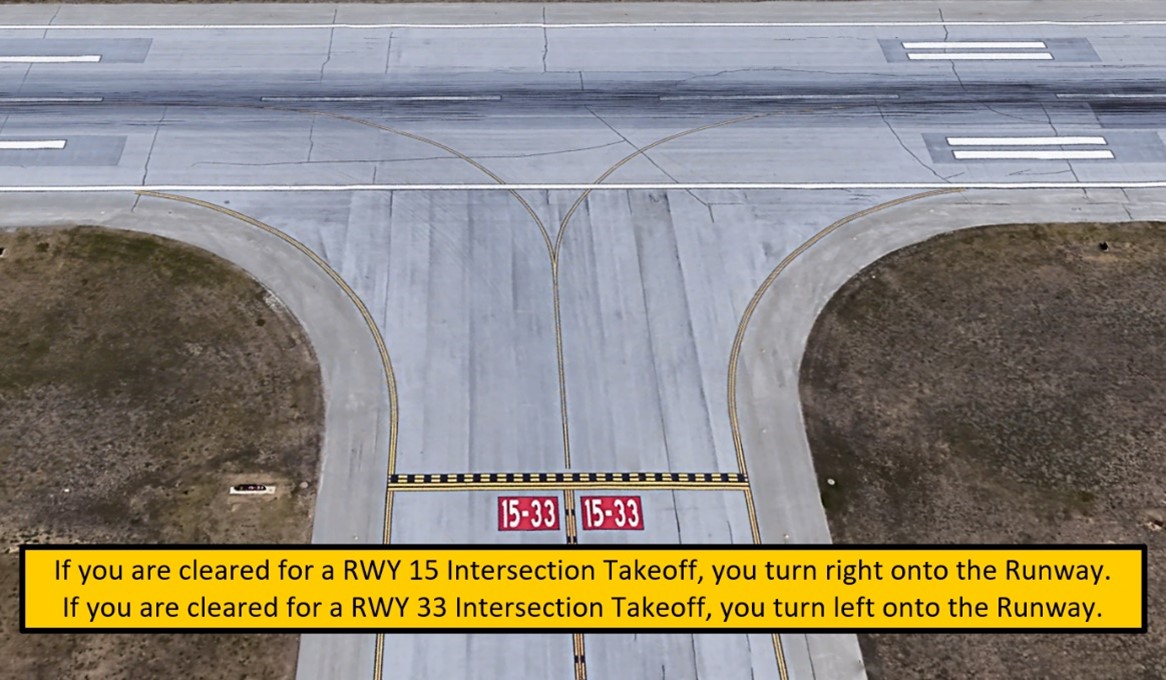
- At Hot Spot 2, pilots, cleared for takeoff on RWY 19 have departed on RWY 15 in error.
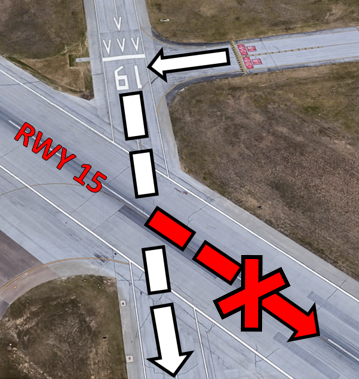
- A pilot, cleared to takeoff on RWY 19, attempted to takeoff straight ahead on TWY G, instead of turning right onto RWY 19. TWR intervened.
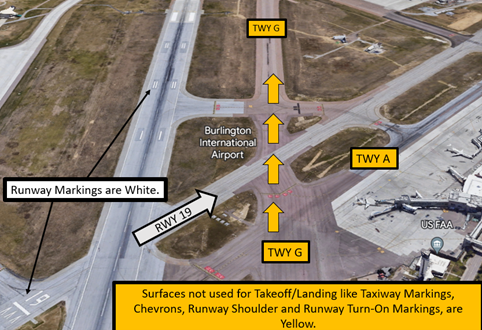
Landing
- Wrong Surface Landing risk exists where whenever a full-length TWY parallels the RWY. Positive identification of the landing RWY needs to be a part of every pilot’s landing checklist. (See example in illustration below.)
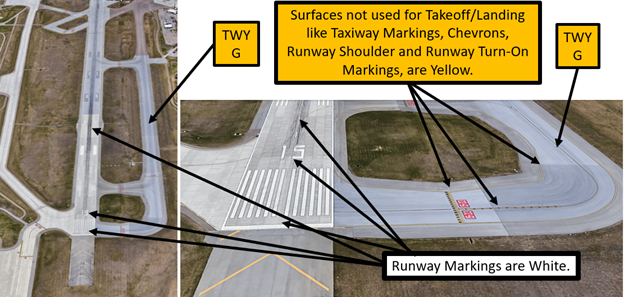
Surface Risk – Movement Area
At HS 1, the RWY 19 Hold Short Line approaches quickly after clearing RWY 15/33.
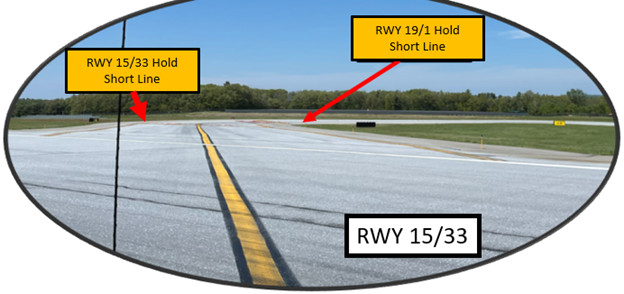
Notice that the RWY 19/1 Hold Short Line is barely visible at this point.
Make sure that you hold short of RWY 19 after crossing RWY 15/33.
- HS3 is located at the intersection of RWY 01/19 and TWY B. Pilots have missed the hold short line for the RWY. Be aware that TWY B makes a slight turn after crossing RWY 01/19.
- HS 4 is located at the intersection of RWY 01/19 and TWY C. Pilots have missed the Hold Short Line for the RWY.
- Be aware that at Hot Spots 3 and 4, you have direct access from the ramp to the RWY. The RWY comes up shortly after exiting the ramp, and because of this, some pilots have failed to hold short of the RWY.
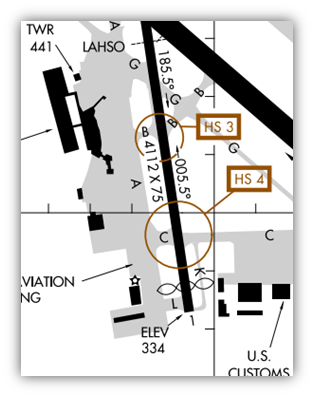
- Air Carrier ramp not available for private and charter aircraft.
- TWYs D, E, F and N are restricted to military aircraft only and are closed to civilian operations.
- TWYs D, E, F, N, ANG and RNG ramps have uncontrolled vehicles and aircraft.
- TWY M available for seasonal use, closed during winter months.
Additional Cautions
- If ever in doubt about your position or instructions, ask the TWR.
- Generating plant 2NM from the approach end of RWY 15 produces steam which may obscure visibility on final approach.
- Increased migratory bird activity Mar-May and Aug 15 – Nov 15.
- See Chart Supplement for military operations.
- See Chart Supplement for wingspan limitations and restrictions.
- One of the few remaining VORs in the region is located at KBTV. Be aware that the VOR RWY 01 approach is frequently used for instrument training.
- Land and Hold-Short Operations (LAHSO) – See Chart Supplement
- RWY 01
- RWY 15
- RWY 33
Traffic Patterns
- ATC may delay slower traffic to accommodate faster aircraft for efficient traffic management.
- Pattern work may be limited during times of heavy traffic.
Ground
- When departing RWY 19, expect to first hold short of RWY 15 at TWY A. When directed to cross RWY 15 at TWY A, do not go past the Hold Short Line for RWY 19 without further instructions from TWR. After crossing RWY 15, you will find that the Hold Short Lines for RWY 15 and RWY 19 are very close to each other. (See illustration below.)
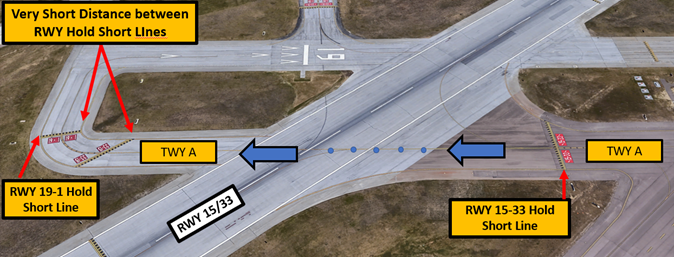
Takeoff/Departure
- TWR will normally assign departing aircraft an initial heading. Fly this assigned heading until receiving further instructions from TWR or Departure Control.
Arrival/Landing
- Advise Approach Control of any special requests as soon as possible, such as pattern work at BTV, sightseeing over downtown Burlington, or practice instrument approaches.
- Heightened pilot awareness of step-down fix altitudes on the ILS/RNAV RWY 33 Approach. Pilots should review NOTAMS for the Letter to Airmen LTA-BTV-33 for specific information.
Special Traffic (Military / Commercial / Helicopter, etc.)
- Use caution for jet blast by commercial aircraft near terminal ramp.
- Helicopters should advise Clearance Delivery of requested departure point.
- Be alert for high-speed fighter aircraft within BTV airspace.
Additional Information
- RWY 33, RWY 01 and RWY 19 have displaced thresholds.
- Use caution for mountainous terrain in the vicinity of BTV.
